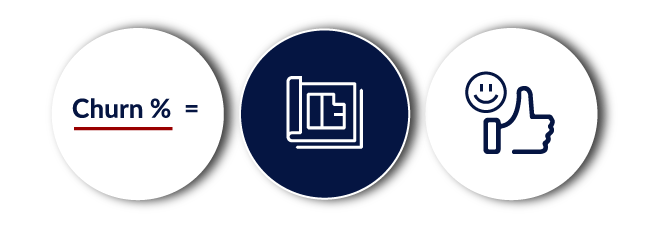It’s been proven - people don’t buy goods and services anymore. They buy relationships, stories and magic. In such an environment, getting customers to believe in your product as much as you do is key to your success. But that’s not all. While you need to ensure their success, you also need to measure your efforts. In short, are your customer success management efforts enough?
Considering your direct competitors have become more customer-focused, it’s critical to keep pace with them. Better yet; if you can provide your customers with a solution that can quickly reduce their sources of stress and irritation, you’re that much more competitive. How? Focus on guiding your customers to master your product.
It’s what we at DotActiv strive to do. Getting it right requires a solid relationship.

Customer Support vs Customer Success: What’s the Difference?
Before we dive further into customer success management and the key measures that we use to gauge our efforts, it’s important to know the difference between success and support.
Defining each clearly means we can pinpoint our strengths and weaknesses. And with that, we can become better at planning our efforts. Of course, it’s worth pointing out that both work alongside each other to provide a better customer experience.
Customer Support
Support entails solving issues or problems that customers might experience while using a product or service.
Here, the support team answers customer queries or concerns and usually spends their time fixing things. These can be common products or issues specific to their environment.
Either way, the path is the same: a customer has a problem, they ask us for assistance; we provide them with a solution.
That’s why you can refer to customer support as reactive. The goal is to solve a problem quickly so that customers can complete what they need to do. In that way, it’s positive and has a clearly defined purpose. It’s a critical part of our business.
However, at the same time, the nature of customer support is short-term. As soon as you solve one problem, you’re faced with another.
It’s also worth pointing out that this part of the business is not a revenue centre.
Customer Success
While the focus of customer support is to provide a solution, customer success is about encouraging your customers to become self-sufficient. A better word might be empowerment.
You need to empower your customers. That’s especially true if you’re a business like DotActiv that offers software products or services. It’s critical to pay as much attention to customer success as we would customer support. In truth, we could argue that we should place more emphasis on this part of our business.
After all, the focus here is to assist customers to derive as much value from our category management software or services as possible. That makes this proactive instead of reactive. Also, instead of solving the short-term needs of our customers, we can start focusing on the long-term.
It’s also worth pointing out that assisting customers to master our product or service isn’t only beneficial to them. It’ll also benefit our bottom-line. We know that businesses like ours who don’t have a customer success framework in place are potentially missing out on an untouched pot of revenue.
Metrics DotActiv uses to measure its customer success management efforts
There are plenty of metrics out there that you can use to measure your customer success management efforts. Of course, that also means that you can, quite easily, get lost in the myriad.
For the sake of brevity, we’ve chosen the three metrics that DotActiv uses to measure its success in this regard.
Churn Rate
Churn rate is a metric that measures retention. It provides us with a holistic view of those customers who quit our product within a given period. What’s more, it offers us a view of the financial implications.
While customer churn rate is common across businesses, regardless of the industry, that doesn’t mean you should accept it. Instead, it’s critical to minimise it.
There are three types of churn that we can measure:
- Customer Churn: As mentioned above, this is the percentage of customers who quit a product over a given period.
- Monthly Recurring Revenue Churn (MRR churn): Also known as gross churn, this measures the percentage of total revenue lost as a result of customer churn. It also includes the percentage lost due to downselling or downgrading.
- Net Monthly Recurring Revenue Churn (Net MRR churn): While it measures gross churn, it also factors in the gains that result from expansion revenue, which is the revenue that comes from upselling or cross-selling existing customers. Expansion revenue has the potential to help offset some, or all, of the revenue lost from customer churn.
So how do you measure your churn rate?

Expansion Monthly Recurring Revenue
Expansion Monthly Recurring Revenue - Expansion MRR - is a metric that measures the percentage of new revenue that comes from existing customers.
For example, how often do customers upgrade from a lower-tier plan to a higher-tier plan?
The higher the percentage, the better our efforts at empowering our customers to use our product or service.
You can also link this back to the level of support. If we don’t solve short-term problems, we’ll struggle to offer long-term success.
Here’s how to measure expansion monthly recurring revenue:

Customer Satisfaction
While churn rate and expansion revenue focus more on what your customers do, the focus shifts when it comes to this section. Here, it’s about how customers feel.
As a customer success manager, it's critical that we understand customer perceptions of our business. How do they feel about our products and services? That allows us to take action before a customer decides to downgrade or quits our product.
By measuring customer satisfaction, we can identify those customers who are most at risk of downgrading or churning and work toward improving their experiences.
We can measure customer satisfaction in one of two ways:
The first is via a Net Promoter Score (NPS). The Net Promoter Score measures the willingness of customers to recommend products or services based on questions answered in a survey. We provide a scale as part of the survey with questions asking customers to rate their willingness between 0 and 10.
From there, we group customers into three categories (0 to 6 is detractors, 7 to 8 is passives and 9 to 10 are promoters) based on their responses.
Then to determine the actual NPS score, subtract the percentage of people in the detractor category from the percentage of people in the promoter category.

The second way to measure customer satisfaction is through a Customer Satisfaction Score (CSAT). This is a useful metric when looking at the short-term happiness of customers. Also presented as a survey, it asks the question: How would you rate your overall satisfaction with [Product/Service]?’
Customers can then give a response on a scale of between one and five. One could be ‘very unsatisfied’ while five is ‘very satisfied’.
The resulting CSAT score can be represented as a percentage between 0 and 100 based on how many customers were ‘satisfied’ or ‘very satisfied’.

Conclusion
It’s all good and well to have these customer success management metrics in place, but they carry little to no value if we don’t have benchmarks to measure them against. These KPI benchmarks serve as goals to work towards and are specific to our business and environment.



